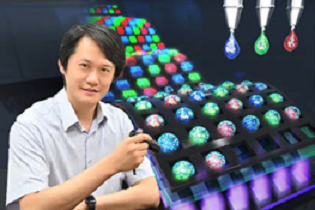Scientists encapsulate quantum dots in salt
It’s widely known that submerging a pared apple in saltwater prevents oxidation and browning, but did you know that saltwater can also protect fragile quantum dot (QD) materials? A research team led by Prof. Chen Hsueh-shih of the Department of Materials Science and Engineering at National Tsing Hua University in Taiwan has recently developed the world’s first technique for using saltwater to encapsulate QD materials, which not only resists water and oxygen corrosion, but can also be uniformly printed as a microLED on flexible plastic film for use in high-resolution bendable screens for mobile phones, glasses, etc.
In order to create ultra-slim and bendable displays with higher resolution, higher brightness, and a longer lifetime for use in the goggles used in augmented reality (AR) and virtual reality (VR), and for watches and other wearable electronic devices, Apple, Samsung, and other major panel manufacturers have heavily invested in the development of microLEDs to replace the OLED displays currently in use. 
Arranging millions of microLEDs less than 100 μm in size on a substrate presents some major difficulties. According to Chen, many manufacturers use a stamping method to move millions of red, green, and blue microLEDs one-by-one to the substrate, but if just a few dots don’t stick, the screen will be marred by defective pixels.
One way of solving this problem is to use inkjet printing to arrange the microLEDs, which is more efficient and cost effective. However, when the QD solution is ejected from the inkjet printer, convection occurs inside the droplets, pushing the material to the periphery, leaving it unevenly distributed, with a lighter color in the center and a darker color on the periphery, similar in appearance to the so-called “coffee ring phenomenon” seen in a drop of coffee dropped onto a light surface.
By adding saltwater (a sodium chloride solution) to the QD solution, Chen’s research team successfully encapsulated the QDs, which formed into crystals, what Chen describes as “grabbing hold of the quantum dots and condensing them into uniformly distributed dots.” These encapsulated QDs are also more stable and corrosion resistant, like apples soaked in saltwater.
The team member who came up with the idea of soaking the quantum dots in saltwater was Dr. Ho Shih-jung, also of the Department of Materials Science and Engineering at National Tsing Hua University. He observed from photomicrographs that QD material without added saltwater scatters into irregular shapes when ejected from an inkjet printer, but by adding saltwater, they gradually shrink and converge into uniform and beautiful crystals.
According to Ho, adding saltwater to the QD solution also makes it possible to spray smaller droplets, explaining that the droplet size of current QD printers is about 30 μm to 50 μm, but by adding saltwater the size can be reduced to as small as 3.7 μm, which is about 1/20 the diameter of a human hair, hence the better resolution.
This innovative research has been published in a recent issue of ACS Applied Materials & Interfaces, and the material they have developed is currently being patented in the United States and Taiwan.
